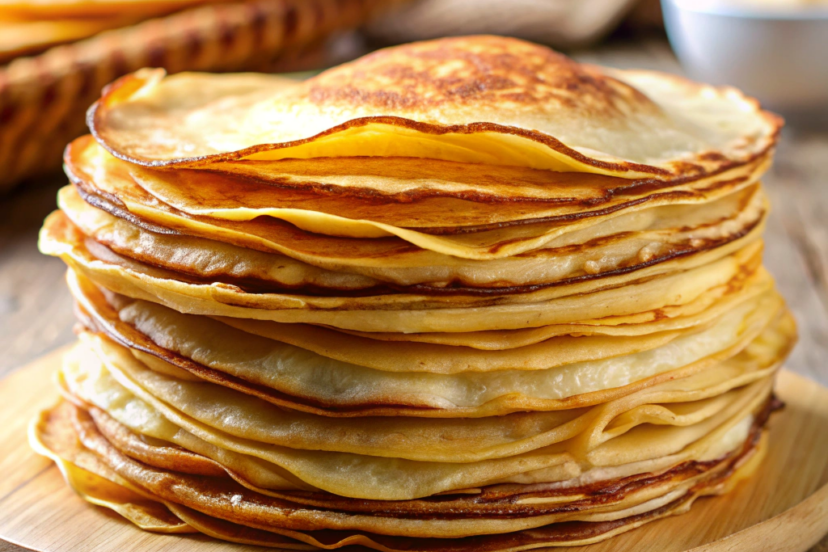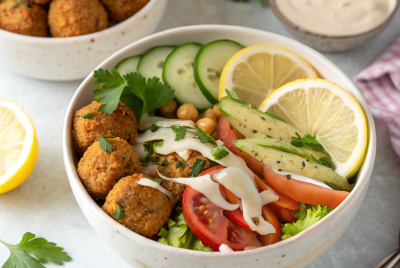Easy Dairy-Free Crepe Recipe (Gluten-Free Option)
Hey there, fellow foodies! If you’re anything like me, you probably love indulging in a delicious crepe every now and then. Whether it’s for breakfast, an afternoon tea, a weekend brunch or a special treat, crepes are a fantastic option. However, if you’re dairy-free, finding a good crepe recipe can be quite the challenge. Well, fret not! Today, I’m going to share my absolute favorite dairy-free crepe recipe that also has a gluten-free option for those who need it. So, grab your mixing bowl and let’s get started!
Personal Story: My First Time Making Dairy-Free Crepes
The first time I made dairy-free crepes, I was a bit nervous. I had always relied on traditional recipes with dairy, and I wasn’t sure how the crepes would turn out without it. But to my delight, they were even better than expected! The crepes were light, fluffy, and oh-so-delicious. It was a total win in my kitchen, and I’ve been making them ever since.
What’s a crepe?
A crêpe is a type of very thin pancake that originated in France. Unlike traditional pancakes, crepes are known for their delicate texture and versatility. They can be enjoyed in both sweet and savory forms, making them a popular choice for any meal of the day. Sweet crepes are often filled with ingredients like fresh fruit, chocolate, and whipped cream, while savory crepes can include fillings such as cheese, ham, and vegetables. Typically made from a simple batter of flour, eggs, milk, and a pinch of salt, crepes are cooked on a hot, lightly greased pan until they are golden and slightly crispy around the edges.
Why Dairy-Free Crepes?
The Need for Dairy-Free
Going dairy-free has been a game-changer for my digestion and overall health. Dairy products can be tough on many people, causing bloating, discomfort, or even allergic reactions. This dairy-free crepe recipe is a lifesaver for anyone with dairy sensitivities or for those who simply want to cut down on their dairy intake.
Gluten-Free Option
For those of you who are gluten-intolerant or have celiac disease, this recipe includes a gluten-free flour option. It’s important to enjoy delicious foods without compromising your health.
The Basics: Ingredients and Tools
Basic Ingredients
• 1 cup of all-purpose flour (or gluten-free flour for the gluten-free option)
• 2 tablespoons of brown sugar (for sweet crepes)
• 2 large eggs (room temperature)
• 1 1/2 cups of almond milk (or any dairy-free milk like oat milk, soy milk, or coconut milk)
• 1 tablespoon of melted coconut oil (or olive oil)
• 1 teaspoon of vanilla extract
Tools You’ll Need
• Large bowl
• Whisk
• Measuring cup
• Crepe pan or a non-stick pan
• Paper towel for greasing the pan
Making the Perfect Dairy-Free Crepe Batter
Step 1: Mix the Dry Ingredients
In a large bowl, combine the all purpose flour (or gluten-free flour) and brown sugar. These dry ingredients form the base of your crepe batter.
Step 2: Whisk the Wet Ingredients
In a separate bowl, whisk together the eggs, dairy-free milk (I usually go for almond milk), melted coconut oil, and vanilla extract. Make sure everything is at room temperature to ensure a smooth mixture.
Step 3: Combine and Rest
Slowly pour the wet mixture into the dry ingredients, whisking continuously to avoid lumps. Once combined, let the crepe batter rest for about 30 minutes. This step is crucial for achieving thin pancakes that cook evenly.
Note: For savory crepes, omit the sugar. You can add herbs like finely chopped spring onion in the batter for extra flavour.

Cooking Your Dairy-Free Crepes
Step 1: Heat the Pan
Heat your crepe pan or non-stick skillet over medium heat. Lightly grease the pan with a bit of coconut oil using a paper towel.
Step 2: Pour the Batter
Using a measuring cup, pour about 1/4 cup of batter into the pan. Tilt the pan in a circular motion to spread the batter evenly, creating a thin layer.
Step 3: Cook to Perfection
Cook for about 1-2 minutes on one side until the edges start to lift. Flip and cook for another 2-3 minutes until golden brown. Repeat with the remaining batter.
Why This Recipe Works
Simple Ingredients
This recipe uses simple ingredients that you probably already have in your pantry. No need for a special pan or exotic items.
Versatile and Adaptable
Whether you prefer sweet crepes or savory crepes, this recipe is incredibly versatile. You can mix and match your favorite fillings to suit your taste.
Perfect for Everyone
This dairy-free crepe recipe is perfect for those with food allergies or dietary restrictions. It’s a great way to enjoy a French classic without the worry.
Tips and Tricks to Make the Perfect Dairy-Free Crepes
Making the perfect dairy-free crepes can be a bit of an art, but with these tips and tricks, you’ll be flipping flawless crepes in no time!
1. Choose the Right Dairy-Free Milk
The type of dairy-free milk you use can impact the texture and flavor of your crepes. Almond milk and oat milk are great choices for their mild flavors and smooth consistency. If you prefer a creamier texture, coconut milk works well too. Just make sure to use a plant-based milk that you enjoy drinking.
2. Use a Thin Batter
Your crepe batter should be quite thin—similar to heavy cream. A thin batter ensures that the crepes spread out evenly in the pan, creating those delicate, thin pancakes. If the batter is too thick, it will result in thicker, less flexible crepes. If needed, add a bit more dairy-free milk to achieve the right consistency.
3. Let the Batter Rest
Allow your crepe batter to rest for at least 30 minutes before cooking. This step helps the flour absorb the liquid fully and gives the gluten a chance to relax, resulting in more tender crepes. If you’re short on time, even a 10-minute rest can make a difference.
4. Preheat Your Pan
A well-heated pan is crucial for cooking perfect crepes. Use a crepe pan or a non-stick skillet and preheat it over medium heat. You want the pan to be hot enough to cook the crepes quickly but not so hot that they burn.
5. Lightly Grease the Pan
Use a small amount of coconut oil, olive oil, or vegan butter to lightly grease the pan. You can use a paper towel to spread the oil evenly and remove any excess. Too much fat can make the crepes greasy, while too little can cause them to stick.
6. Use the Right Amount of Batter
Pour about 1/4 cup of batter into the hot pan. Tilt and swirl the pan in a circular motion to spread the batter thinly and evenly. If you pour too much batter, the crepes will be thick and might not cook properly.
7. Cook on Medium Heat
Cook the crepes on medium heat to ensure they cook evenly without burning. The edges will start to lift and become golden brown. Flip the crepe with a spatula and cook the other side for an additional 1-2 minutes.
8. Avoid Overcooking
Crepes cook quickly, so keep an eye on them to avoid overcooking. They should be lightly golden and slightly crispy around the edges. Overcooking can make them dry and tough.
9. Experiment with Flavors
Feel free to add a dash of vanilla extract or a bit of brown sugar to the batter for extra flavor. You can also experiment with different dairy-free milk options to find your preferred taste.
10. Keep Your Crepes Warm
If you’re making a large batch, keep the finished crepes warm by placing them on a baking sheet in a low oven (around 200°F) or covering them with a clean kitchen towel to retain moisture.
By following these tips and tricks, you’ll be well on your way to making perfect dairy-free crepes every time. Enjoy experimenting with different fillings and flavors to create your ideal crepe experience!
Sweet and Savory Fillings
Sweet Crepes
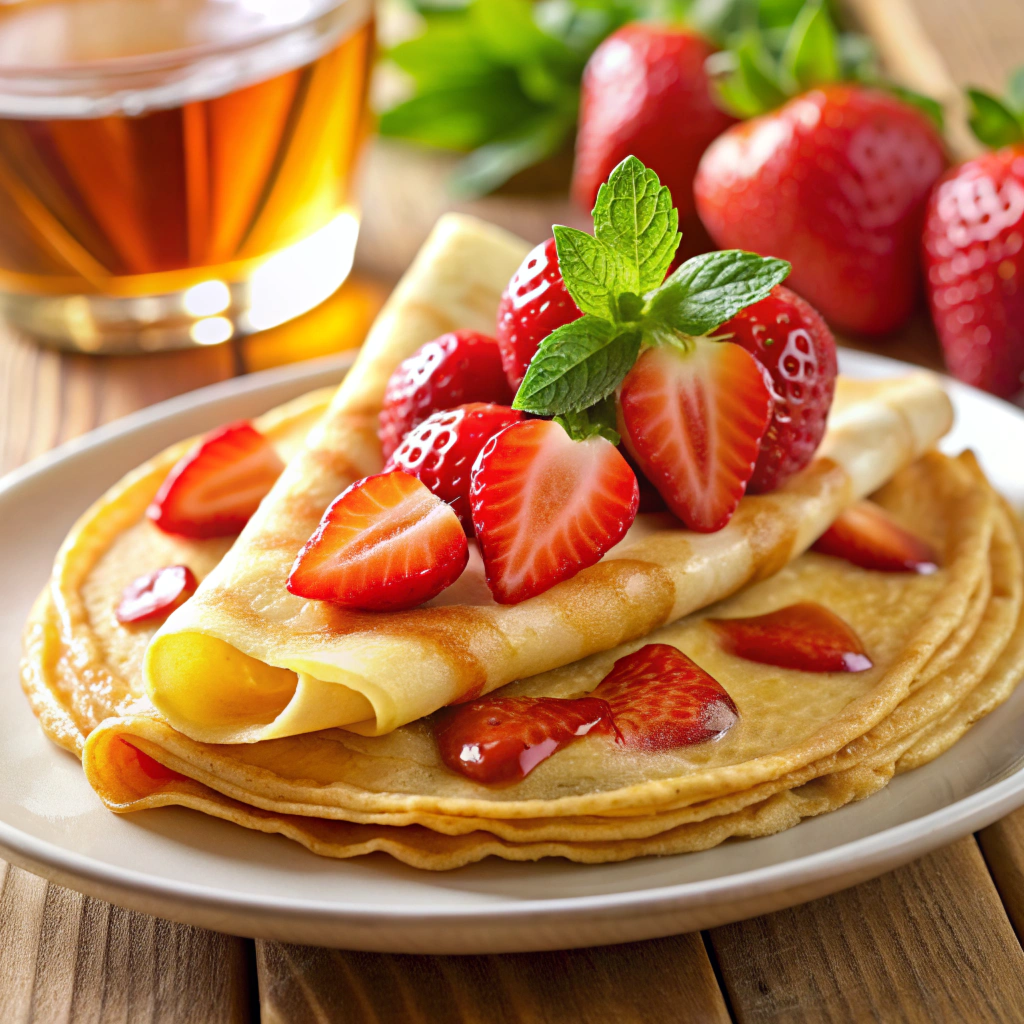
Sweet crepes are a delightful treat that can be filled with a variety of delicious ingredients. Some of my favorites include:
- Fresh fruit like strawberries, blueberries, or bananas
- Maple syrup or vegan butter
- A chocolate spread like Nutella
- Jam
- Bananas and a chocolate sauce (melted chocolate or Nutella)
- Bananas and peanut butter
- Cinnamon sugar
- Grated desiccated coconut and sugar
Savory Crepes
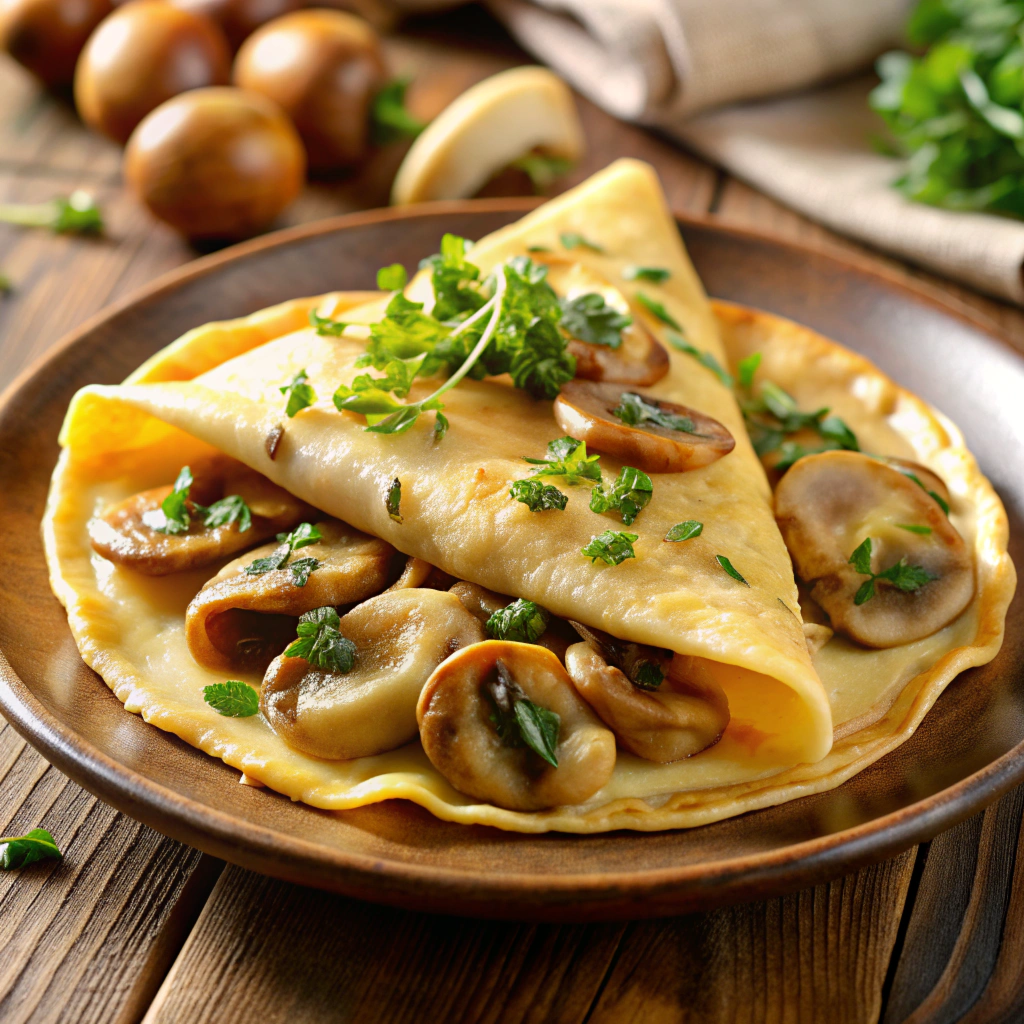
Savory crepes make a fantastic meal. Here are a few savory fillings to try:
- Vegan cheese or vegan cream cheese
- Vegan cheese and sautéed mushrooms
- Spinach and vegan cheese
- Avocado and tomato with a drizzle of olive oil
Printable Recipe Card
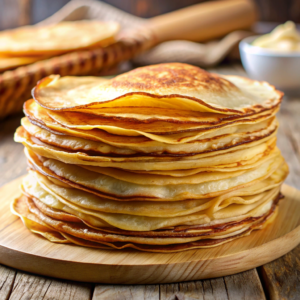
Easy Dairy-Free Crepe Recipe (Gluten-Free Option)
Equipment
- Whisk
- Measuring cup
- Crepe pan or a non-stick pan
- Paper towel for greasing the pan
Ingredients
- 1 cup of all purpose flour or gluten-free flour
- 2 tablespoons of brown sugar
- 2 large eggs room temperature
- 1 1/2 cups of almond milk or oat milk, soy milk, or coconut milk
- 1 tablespoon of melted coconut oil or olive oil
- 1 teaspoon of vanilla extract
Instructions
- In a large bowl, mix the all purpose flour (or gluten-free flour) and brown sugar.
- In another bowl, whisk together the eggs, almond milk, melted coconut oil, and vanilla extract.
- Gradually add the wet mixture to the dry ingredients, whisking to combine.
- Let the crepe batter rest for 30 minutes.
- Heat a crepe pan or non-stick skillet over medium heat and lightly grease with coconut oil.
- Pour about 1/4 cup of batter into the pan, spreading it in a circular motion.
- Cook for 1-2 minutes on each side until golden brown.
- Serve with your favorite sweet or savory fillings.
Notes
Nutrition
Discover other vegan and/or gluten-free recipes below:
Easy Vegan Eclair Recipe (With Gluten-Free Option)
Best Dairy-Free Vanilla Cupcakes (Gluten-Free Option)
Keto Vegan Chocolate Chip Cookies | Sugar & Gluten Free
30 Spooky Halloween Food Ideas: Vegan & Gluten-Free
Vegan Gluten Free Greek Food: 30 Mediterranean Recipes
Best Homemade Gluten Free Ciabatta Bread Recipe
Easy Dairy Free Bread Recipes (Gluten-Free Option)
Best Gluten Free Substitutes for Farro + 10 Recipes
Storing and Reheating Your Crepes
Storing Crepes
These dairy-free crepes can be made ahead of time and stored in an airtight container in the refrigerator. They’ll stay fresh for up to 3 days. Just reheat them in a non-stick pan when you’re ready to eat.
Freezing Crepes
Crêpes can be frozen. Layer them with parchment paper in between and store in a freezer-safe bag. Reheat them in a pan when needed.
Reheating Crepes
To reheat your crêpes, place them in a non-stick pan over medium heat for about 1-2 minutes on each side. They’ll be just as delicious as when they were first made!
End Words
Making dairy-free crepes at home is a fun and rewarding experience. With this easy recipe, you can enjoy delicious crepes without the dairy. Whether you go for a sweet or savory version, these crepes are sure to become a favorite in your household. So, give it a try, and let me know how it turns out!
FAQs
1. What’s the best dairy-free milk for this recipe?
I love using almond milk for its mild flavor, but you can also use oat milk, soy milk, or coconut milk.
2. What can I use instead of eggs to make vegan crepes?
You can use a flax egg (1 tablespoon of ground flaxseed mixed with 3 tablespoons of water) or a commercial egg replacer.
3. How do I make the crepes extra thin?
The key to thin crepes is to ensure your batter is smooth and to spread it quickly in the pan using a circular motion. Using a crepe pan also helps in achieving the best results.
4. Can I use water instead of milk for crepes?
Yes, you can use water instead of milk for crepes, but keep in mind that the texture and flavor might be slightly different. Using water will make the crepes lighter and less rich compared to using milk or a dairy-free milk alternative like almond milk or oat milk. To maintain some richness and flavor, you might want to add a bit of oil or extra vanilla extract to the batter.
5. Should crepe mixture be watery?
Yes, the crepe mixture should be quite watery, much thinner than traditional pancake batter. A thin batter ensures that the crepes will spread out evenly in the pan, creating those delicate, paper-thin pancakes. If your batter seems too thick, you can gradually add a bit more liquid (such as almond milk or water) until it reaches the right consistency.
6. Why are my crepes not crispy?
If your crepes are not turning out crispy, it might be due to a few factors:
- Heat Level: Ensure that your pan is hot enough. Cooking crepes on medium to medium-high heat allows them to cook quickly and develop a slight crispiness around the edges.
- Thin Batter: Make sure your batter is thin enough. A thicker batter will result in thicker, softer crepes. Add a bit more liquid if needed to achieve a thin, pourable consistency.
- Resting the Batter: Allow your batter to rest for about 30 minutes before cooking. This helps the ingredients to meld together and results in better texture.
- Cooking Time: Cook the crepes long enough on each side. They should be golden brown and slightly crisp around the edges before you flip them.
- Oil or Butter: Lightly grease your pan with a small amount of oil or butter. Too much fat can make the crepes greasy rather than crispy.
By adjusting these factors, you should be able to achieve that perfect crispy texture in your crepes.
7. What happens if you overmix crepe batter?
Overmixing crepe batter can lead to several issues:
- Tough Texture: Overmixing can develop the gluten in the flour too much, resulting in crepes that are chewy and tough instead of light and tender.
- Air Bubbles: Overmixing can incorporate too much air into the batter, leading to bubbles that might make the crepes uneven or cause them to tear during cooking.
- Less Spreadable Batter: An overmixed batter can become too elastic, making it harder to spread thinly in the pan, resulting in thicker crepes.
To avoid these issues, mix the batter just until the wet and dry ingredients are combined and smooth, with no lumps remaining. Letting the batter rest for about 30 minutes can also help achieve a better texture without overmixing.
8. Why are my crepes so dry?
If your crepes are turning out dry, here are a few possible reasons and tips to fix them:
- Overcooking: Cooking the crepes for too long can make them dry and brittle. Keep an eye on them and cook just until they are golden brown and set, usually about 1-2 minutes per side.
- Pan Temperature: If your pan is too hot, the crepes can cook too quickly, resulting in a dry texture. Make sure your pan is at a medium heat.
- Batter Consistency: If your batter is too thick, it can lead to dry crepes. The batter should be thin and pourable, like heavy cream. Add a bit more liquid (such as almond milk or water) to achieve the right consistency.
- Resting the Batter: Allowing the batter to rest for about 30 minutes helps the flour to fully hydrate and results in more tender crepes.
- Fat Content: Ensure you have enough fat in the batter. Adding a bit of melted coconut oil or olive oil helps to keep the crepes moist and tender.
Adjusting these factors should help you achieve perfectly moist and tender crepes.
9. What makes crepes rubbery?
If your crepes are turning out rubbery, it could be due to a few factors:
- Overmixing the Batter: Overmixing can develop the gluten in the flour too much, resulting in a chewy, rubbery texture. Mix the batter just until combined, with no lumps.
- Too Much Flour: Using too much flour can make the crepes dense and rubbery. Ensure you’re measuring the flour accurately and consider sifting it to avoid clumps.
- Cooking Temperature: Cooking the crepes at too low a temperature can cause them to cook slowly and become rubbery. Use a medium to medium-high heat for a quick, even cook.
- Resting the Batter: Skipping the resting time can also affect the texture. Letting the batter rest for about 30 minutes allows the ingredients to meld and results in more tender crepes.
- Pan Preparation: Not properly greasing the pan or using a pan that is not hot enough can result in uneven cooking, contributing to a rubbery texture. Lightly grease your pan with oil or butter and ensure it is heated to the right temperature before adding the batter.
Adjusting these factors should help you achieve crepes that are tender and not rubbery.
10. What is the difference between crepes and pancakes?
Crepes and pancakes may look similar, but they have some key differences in terms of ingredients, texture, and preparation:
Ingredients:
- Crepes: Made with a batter of flour, eggs, milk, and a pinch of salt. They typically do not contain a leavening agent like baking powder or baking soda.
- Pancakes: Include flour, eggs, milk, sugar, and a leavening agent such as baking powder or baking soda, which makes them rise and become fluffy.
Texture:
- Crepes: Very thin and delicate, with a smooth, tender texture. They are more flexible and can be rolled or folded easily.
- Pancakes: Thicker and fluffier due to the leavening agents, with a light and airy texture.
Preparation:
- Crepes: Cooked in a hot, lightly greased pan or crepe pan, spread very thinly to achieve their delicate texture. They are usually cooked for a shorter time and need to be spread evenly in a circular motion.
- Pancakes: Cooked in a hot, greased skillet or griddle, where they are dropped by spoonfuls and allowed to rise and form bubbles before flipping.
Serving:
- Crepes: Can be served either sweet or savory, and are often filled with ingredients like fruit, cream, or cheese, then folded or rolled.
- Pancakes: Typically served sweet, with toppings like syrup, butter, or fruit, and are often stacked in layers.
Overall, while both crepes and pancakes are delicious breakfast options, their distinct ingredients and preparation methods give each a unique texture and flavor.

